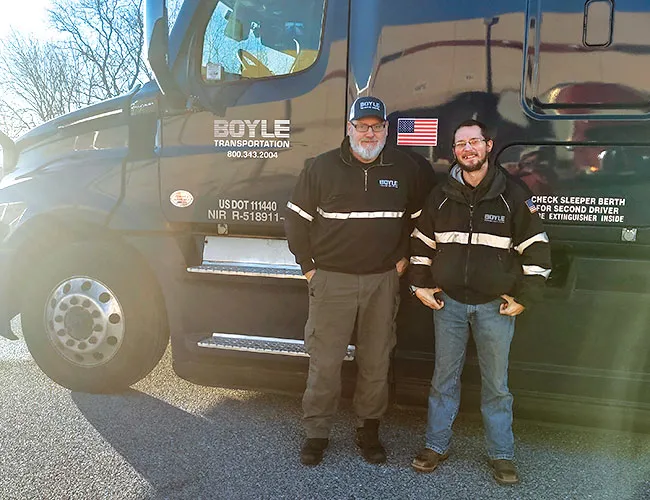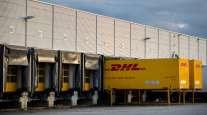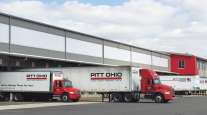Special to Transport Topics
Fleets Navigate the Challenges of Driver Acceptance of ADAS

Boyle Transportation truck drivers Storm Davis (left) and Chance McConnell have some of the consistently highest safety ratings in the company. They fully embrace the safety technology in the trucks they drive. (Boyle Transportation)
[Stay on top of transportation news: Get TTNews in your inbox.]
As innovations such as lane departure warnings, speed and traffic light performance recordings, radars and inward-facing cameras help move advanced driver assistance systems forward, industry experts contend getting drivers to buy in to the technology is key to making sure it is being correctly used.
“We tell our drivers, the way you come to work is the way we want you to go home to your families,” Jeff Mercadante, vice president of safety for Pitt Ohio, told Transport Topics.
He said that acceptance begins with demonstrating the benefits beyond dollars and cents — and is only successful when drivers fully understand the safety benefits each new system brings.
RELATED: How Fleets Evaluate Advanced Driver Assistance Systems
Pitt Ohio began introducing lane departure warning systems in 2006 and then cameras in 2011. Being able to demonstrate exactly how the systems make the trucks — and the roads — safer is key, he said. “What is so critical in rolling out technology is one, explaining the technology to your drivers, communicating everything that technology does,” Mercadante said. “And then you also want to make sure that they understand how it works and what prompts they’re going get.”
Every system the fleet installs — from lane departure warnings to AI-enabled cameras — is carefully evaluated for the potential benefits it could provide against the distraction to the driver. It also is important to understand how all the systems work together, he said.
“You don’t want the entire cab going berserk in the morning or during the day while they’re driving,” Mercadante noted. “You have to make sure that you see how it prompts the driver, so it’s not overwhelming.”

Pitt Ohio, based in Pittsburgh, ranks No. 49 on the Transport Topics Top 100 list of the largest for-hire carriers in North America.
Some drivers push back on the safety systems, saying they feel like they are under constant scrutiny or that human judgment is better. That can be a generational issue, Michael Lasko, vice president of EHS and quality for Boyle Transportation, told TT.
RELATED: Automated Steering Shows Progress
“Younger drivers are going to be more receptive to embracing the technology, and older drivers are a little bit more reluctant to embrace it,” he explained. “But one thing that I’ve found is true for all these groups — the first time one of these systems prevents a serious accident from occurring, all reservations are gone.”

Lasko
Improper education on ADAS can create problems, Lasko said. That’s why training and communication are critical.
In 2015, Boyle introduced the first forward-facing radar systems. Fleet drivers would hear beeps in the cab and think it meant the truck crossed the threshold of safe distance from vehicles in front of them, Lasko said.
“Well, guess what? That isn’t what the beeping meant,” he explained. “The beeping meant you have already been too close and now you’re gaining on that object in front of you or the vehicle in front of you. But the drivers in unison, all throughout the fleet, interpreted that beeping to mean they were just getting too close.”
The misconception helped the company pinpoint a need for thorough training on all systems a driver is likely to encounter, he said.
Like many companies, Boyle provides drivers with safety-related reviews and rewards top performers. Many of the data points in the reviews come from the safety systems themselves.
Storm Davis and Chance McConnell have been driving together for more than five years, most recently at Boyle. They have some of the consistently highest safety ratings in the company, Lasko said.
“Both Storm and I want to come home every week. I would feel terrible if I was driving and I did something that got Storm hurt and his family would suffer,” McConnell told TT. “Not only that, for the safety of the public; We, all the other drivers, have a big responsibility.”
I think the alerts that [the ADAS
safety technology] gives are minimal
compared to the safety that it actually promotes.Chance McConnell
Boyle Transportation truck driver
In addition to the company that owns the truck, he said, drivers have a responsibility to the customers.
“Our customers pay Boyle to get that product there in a timely manner and safe in the same package the way they shipped it,” McConnell added.
Because of those responsibilities — to each other, the drivers and the companies — Davis and McConnell said they fully embrace the safety technology in the trucks they drive.
“I think the alerts that it gives are minimal compared to the safety that it actually promotes,” McConnell said.
One recent instance: McConnell was driving at night when a large plastic water barrel came unsecured and landed in the middle of the lane. Lacking lights or reflective tape, the driver said he had no idea the obstacle was in the road. However, the forward-facing radar spotted it.
Lori Heino-Royer of Waabi discusses the latest developments, breakthroughs and key industry partnerships in autonomous trucking. Tune in above or by going to RoadSigns.ttnews.com.
“I’d have never seen it, but since it had metal wrapped around it, the radar picked it up and saved me from an accident,” he said, adding the advanced safety systems have made him a safer driver overall.
Lasko said its drivers act as ambassadors of sorts for the safety program. The company has a professional drivers’ committee that meets monthly to review the performance of safety technology.
“Drivers would say, ‘Hey, you know, I used to hate the automatic emergency braking because once in a blue moon, it will have a false positive,’ ” Lasko said, describing the meetings.
He noted that reluctance usually lasts until the technology prevents an accident. Seeing the technology work and hearing from their peers about the assistance goes a long way to getting drivers to buy in.
Other companies agreed with the idea that training and demonstration are the best ways to get driver support.

Miller
Jennifer Miller, vice president of integrated transportation solutions at DHL Supply Chain, noted that the purpose of this technology is to encourage safer driving behavior before an incident happens.
“The focus must be on leading behavior versus lagging metrics. If you are only waiting until after an incident happens to learn from it, you are always behind,” she wrote in an email to TT. “It also helps our drivers understand behaviors they may not have been aware of or understood how dangerous they can be while driving.”
DHL Supply Chain, based in Westerville, Ohio, ranks No. 14 on the Transport Topics Top 100 list of the largest logistics companies in North America.

Mercadante said Pitt Ohio is working with manufacturers to get an improved system that will help prevent lane change and merge accidents: a sideview mirror-based system that unobtrusively alerts drivers that there could be another vehicle in their blind spot. It’s a newer technology, however, and is still undergoing rigorous testing.
“You can’t just take it out and put it on all your vehicles,” Mercadante said. “You don’t know how it works, and you don’t know how it’s going to affect the drivers.”
Want more news? Listen to today's daily briefing below or go here for more info:





